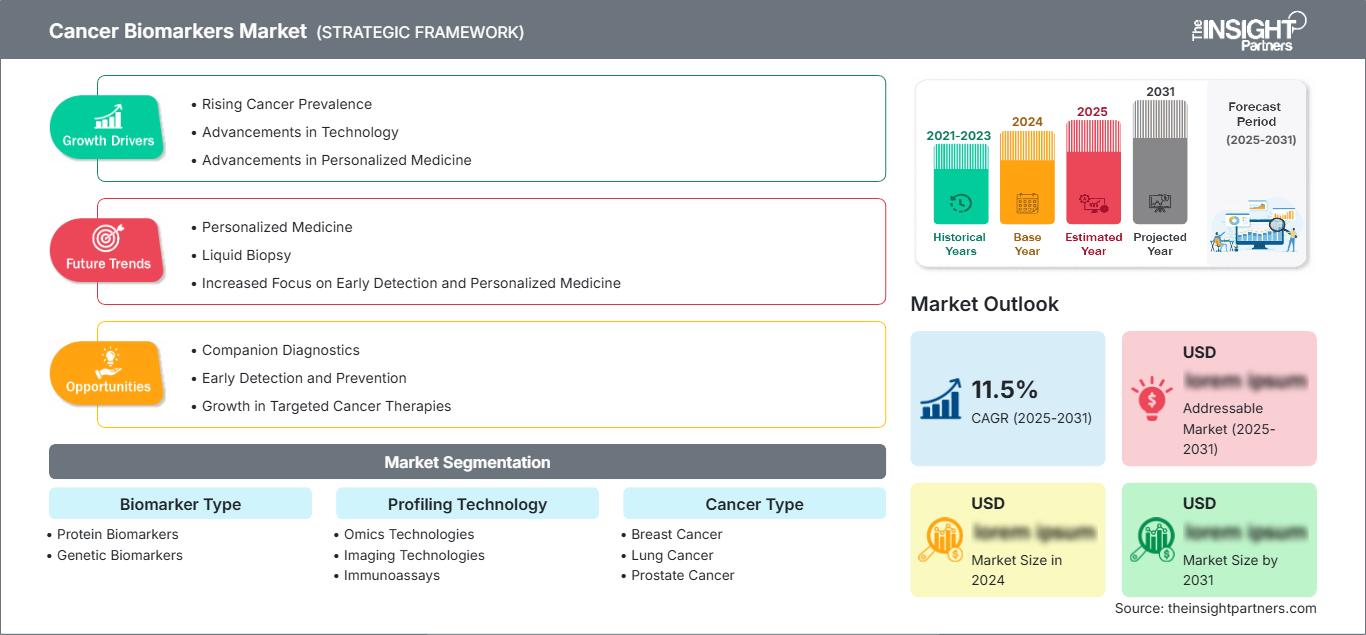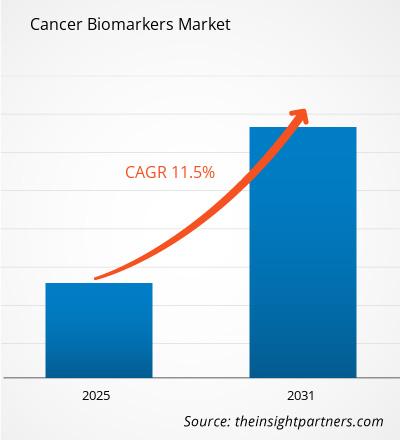The Cancer Biomarkers Market size is expected to reach US$ 83.9 billion by 2031. The market is anticipated to register a CAGR of 10.8% during 2025-2031.
The report is segmented based on Biomarker Type (Protein Biomarkers, Genetic Biomarkers), Profiling Technology (Omics Technologies, Imaging Technologies, Immunoassays, Cytogenetics, Bioinformatics), Cancer Type (Breast Cancer, Lung Cancer, Prostate Cancer, Leukemia, Bladder Cancer) and Application (Prognostics, Diagnostics, Research Development). The global analysis is further broken down at the regional level and major countries. The global analysis is broken down at the regional level and major countries. The market evaluation is presented in US$ for the above segmental analysis.
Purpose of the Report
The report Cancer Biomarkers Market by The Insight Partners aims to describe the present landscape and future growth, top driving factors, challenges, and opportunities. This will provide insights to various business stakeholders, such as:
- Technology Providers/Manufacturers: To understand the evolving market dynamics and know the potential growth opportunities, enabling them to make informed strategic decisions.
- Investors: To conduct a comprehensive trend analysis regarding the market growth rate, market financial projections, and opportunities that exist across the value chain.
- Regulatory bodies: To regulate policies and police activities in the market with the aim of minimizing abuse, preserving investor trust and confidence, and upholding the integrity and stability of the market.
Cancer Biomarkers Market Segmentation Biomarker Type
- Protein Biomarkers
- Genetic Biomarkers
Profiling Technology
- Omics Technologies
- Imaging Technologies
- Immunoassays
- Cytogenetics
- Bioinformatics
Cancer Type
- Breast Cancer
- Lung Cancer
- Prostate Cancer
- Leukemia
- Bladder Cancer
Application
- Prognostics
- Diagnostics
- Research Development
You will get customization on any report - free of charge - including parts of this report, or country-level analysis, Excel Data pack, as well as avail great offers and discounts for start-ups & universities
Cancer Biomarkers Market: Strategic Insights

-
Get Top Key Market Trends of this report.This FREE sample will include data analysis, ranging from market trends to estimates and forecasts.
Cancer Biomarkers Market Growth Drivers
- Rising Cancer Prevalence: Increased awareness and diagnosis of various cancer types fuel the demand for biomarkers.
- Advancements in Technology: Innovations in molecular biology and genomics enable the discovery and development of novel biomarkers.
- Advancements in Personalized Medicine: Advancements in personalized medicine and early cancer detection are fueling the growth of the cancer biomarkers market.
Cancer Biomarkers Market Future Trends
- Personalized Medicine: Biomarkers play a crucial role in tailoring treatment strategies for individual patients.
- Liquid Biopsy: Non-invasive techniques like blood tests for early cancer detection are gaining traction.
- Increased Focus on Early Detection and Personalized Medicine: The growing emphasis on early cancer detection and personalized treatment plans is driving the demand for cancer biomarkers.
Cancer Biomarkers Market Opportunities
- Companion Diagnostics: Biomarkers can be used to identify patients who are likely to benefit from specific therapies.
- Early Detection and Prevention: The development of biomarkers for early cancer detection and risk assessment can improve outcomes.
- Growth in Targeted Cancer Therapies: The increasing adoption of targeted therapies presents a significant opportunity for the cancer biomarkers market in personalized treatment.
The regional trends and factors influencing the Cancer Biomarkers Market throughout the forecast period have been thoroughly explained by the analysts at The Insight Partners. This section also discusses Cancer Biomarkers Market segments and geography across North America, Europe, Asia Pacific, Middle East and Africa, and South and Central America.
Cancer Biomarkers Market Report Scope
| Report Attribute | Details |
|---|---|
| Market size in 2024 | US$ XX Billion |
| Market Size by 2031 | US$ 83.9 billion |
| Global CAGR (2025 - 2031) | 10.8% |
| Historical Data | 2021-2023 |
| Forecast period | 2025-2031 |
| Segments Covered |
By Biomarker Type
|
| Regions and Countries Covered |
North America
|
| Market leaders and key company profiles |
|
Cancer Biomarkers Market Players Density: Understanding Its Impact on Business Dynamics
The Cancer Biomarkers Market is growing rapidly, driven by increasing end-user demand due to factors such as evolving consumer preferences, technological advancements, and greater awareness of the product's benefits. As demand rises, businesses are expanding their offerings, innovating to meet consumer needs, and capitalizing on emerging trends, which further fuels market growth.

- Get the Cancer Biomarkers Market top key players overview
Key Selling Points
- Comprehensive Coverage: The report comprehensively covers the analysis of products, services, types, and end users of the Cancer Biomarkers Market, providing a holistic landscape.
- Expert Analysis: The report is compiled based on the in-depth understanding of industry experts and analysts.
- Up-to-date Information: The report assures business relevance due to its coverage of recent information and data trends.
- Customization Options: This report can be customized to cater to specific client requirements and suit the business strategies aptly.
The research report on the Cancer Biomarkers Market can, therefore, help spearhead the trail of decoding and understanding the industry scenario and growth prospects. Although there can be a few valid concerns, the overall benefits of this report tend to outweigh the disadvantages.
Frequently Asked Questions
What are the deliverable formats of the Cancer Biomarkers Market report?
What are the options available for the customization of this report?Â
What are the future trends of the Cancer Biomarkers Market?
What is the expected CAGR of the Cancer Biomarkers Market?
What are the driving factors impacting the Cancer Biomarkers Market?
Which are the leading players operating in the Cancer Biomarkers Market?
- Historical Analysis (2 Years), Base Year, Forecast (7 Years) with CAGR
- PEST and SWOT Analysis
- Market Size Value / Volume - Global, Regional, Country
- Industry and Competitive Landscape
- Excel Dataset
Recent Reports
Related Reports
Testimonials
Reason to Buy
- Informed Decision-Making
- Understanding Market Dynamics
- Competitive Analysis
- Identifying Emerging Markets
- Customer Insights
- Market Forecasts
- Risk Mitigation
- Boosting Operational Efficiency
- Strategic Planning
- Investment Justification
- Tracking Industry Innovations
- Aligning with Regulatory Trends





















 Get Free Sample For
Get Free Sample For